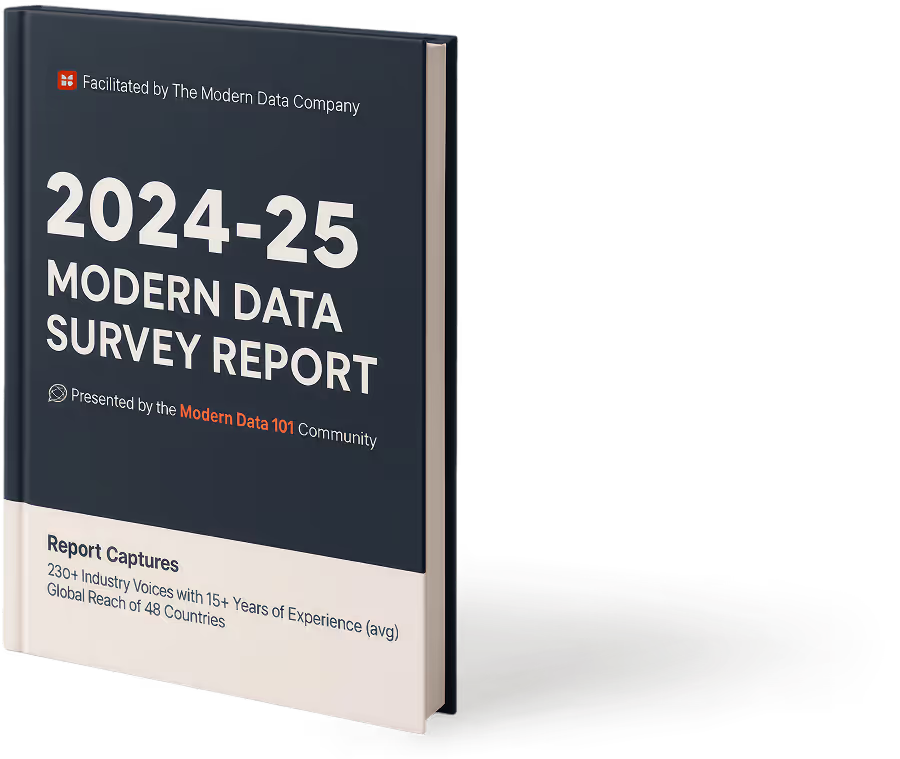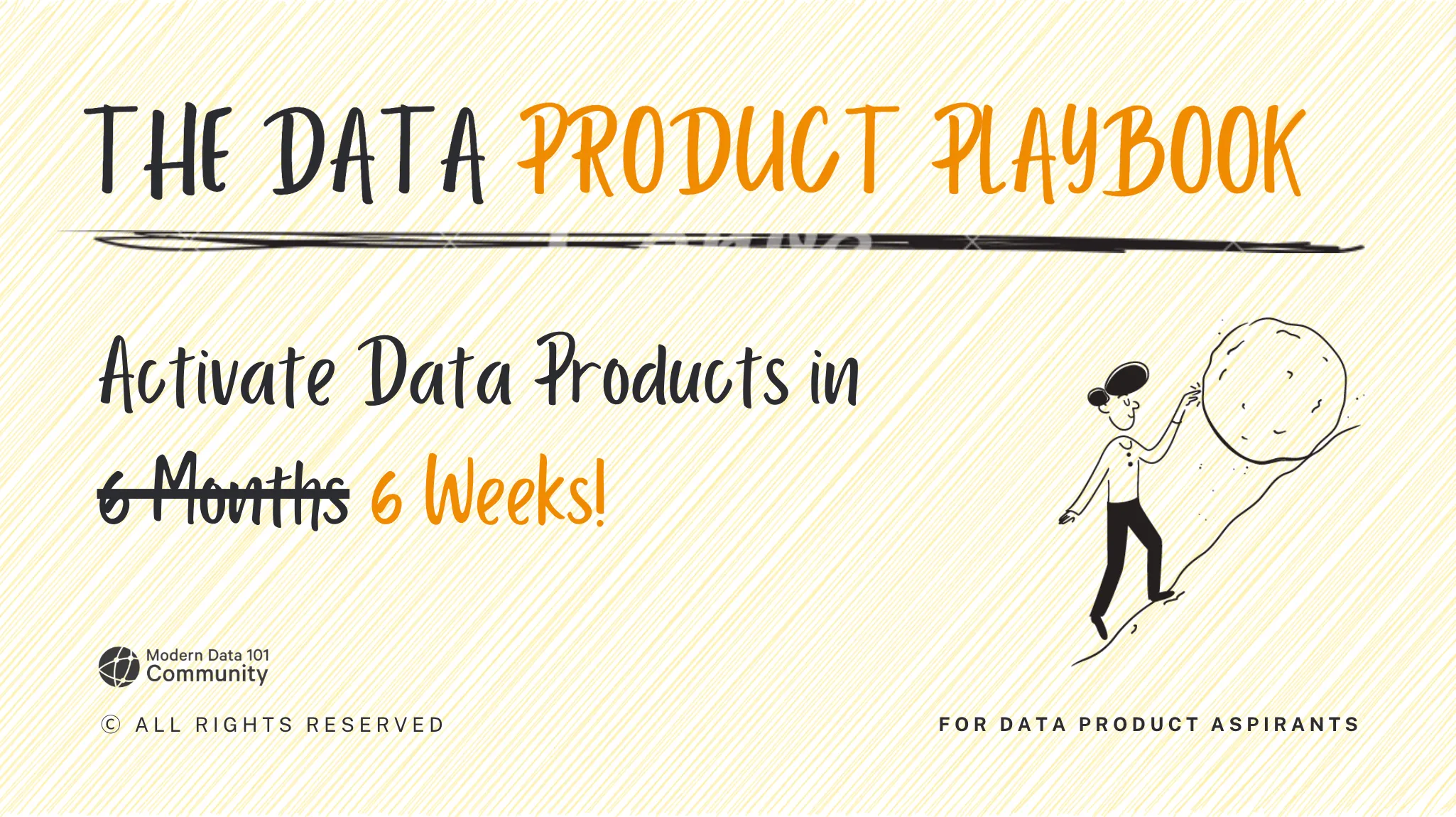
Here's your Playbook
Download now
Oops! Something went wrong while submitting the form.
Learn More
TABLE OF CONTENT

The core objective might be positive, but traditional data governance is often seen more as a bottleneck than an enabler. While governance is designed to safeguard and manage data, it is frequently blamed for slowing down this process, leading to delays at junctures where speed and agility are paramount. It's an interesting but alarming paradox: the structures meant to safeguard data make it difficult for organisations to use that data effectively.
Many data governance challenges arise due to legacy models, such as traditional data warehouses or manual data entry processes, as they are checklist-driven, centralised, and mostly reactive. These approaches may emphasise compliance and control but struggle to match up to the decentralised, dynamic nature of today's data ecosystems.
The centralised nature of data processes isolates data within the organisation, and has become a key challenge globally, costing enterprises more than USD 3.1 trillion each year.
The result? Organisations with governance bottlenecks that hinder innovation and hamper business agility.
Modern data product strategies are a game-changer, empowering you to align governance directly with domain teams. Shifting to a "governed by design" philosophy is easy when governance is inherently embedded into modular and reusable data products.
This approach is about preserving data's integrity and enhancing its usability across different touchpoints in the enterprise. This results in faster insights, improved collaboration, furthered independence from centralised bottlenecks, and wider data democratisation and adoption.
In this new setup, data governance becomes a crucial step up for organisations looking for success in a world where data is becoming both a strategic asset and a competitive advantage.
Before heading into the ‘what’ of data governance, here’s something for intrigue:Data governance has emerged as the fastest growing market in the Asia Pacific region, and is expected to value USD 9.63 billion in 2030, up from USD 3.91 billion in 2025 at a CAGR of 19.72%.
Data governance ensures the accessibility, accuracy, and responsible use of the generated data. Governance has historically relied on centralised standards, policies, and oversight procedures. Here, governance is an additional enabler to data.
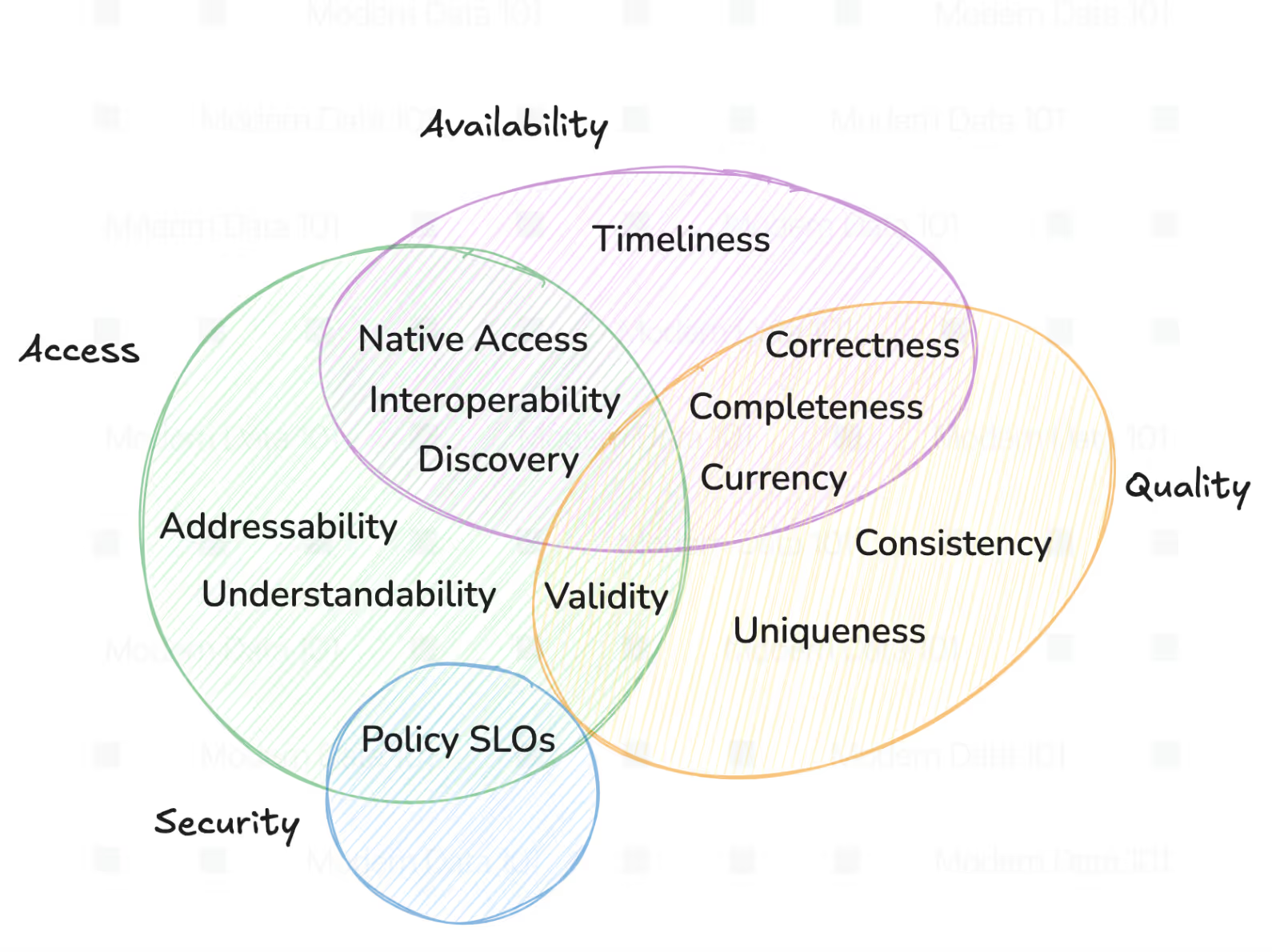
In the case of more effective distributed data ecosystems, governance needs to evolve. It cannot remain a function packed with silos but become an integral part of the data creation and consumption process. Impactful governance is enabled by the data product strategy, instilling a new dimension into conversations around it.
Governance with data products is not an added function or an afterthought, but embedded right into the design. Quality checks, access controls, lineage, and compliance protocols are built within the product. Things are no longer process-heavy, but helpful in ensuring operational trust at scale. When data governance is viewed through the data product approach, it becomes an enabler, more than just a safeguarding process.
Strong governance has four foundational pillars that ensure data's reliability, security, and scalability.
They are given below:
These pillars play a big role in providing a structure for proper governance. However, when paired with data products, data is kept secure and its full potential gets unlocked.
Without proper data governance, organisations risk data breaches, regulatory penalties, and inconsistent reporting, all rooted in unreliable data.
Proper governance ensures that data is secure, reliable, and used responsibly. Despite its impact, governance is considered slow, bureaucratic, and even disconnected at times from the pace of businesses and modern data technologies. Policies get enforced but only as a reactive measure, rules are effectively documented but seldom followed, and many more activities take the velocity away from the entire process. There is a gap between intent and execution in the traditional model, and this is where it falls short.
The data products paradigm changes the game by productising data, making governance part of the architecture, and not just some external checkpoint. From compliance checks to policies, everything important is embedded into the product lifecycle, fostering effective engagement among all stakeholders.
Governance with this data product approach ensures better compliance, reduced risk, and improved sentiment for data as an asset.
Documentation and enforcement have been hallmarks of traditional data governance, where internal teams handle compliance checks, policy manuals, and periodic reviews. The core intent behind this approach might be positive, but everything is still distant from the data's actual utility.
This is a dynamic in which product thinking changes for the better.
The product thinking model is more mature and robust in that governance is no longer treated as a detached layer, but an integral part of the product lifecycle.
This approach helps data products become scalable, evolving with changing business needs and having their own metadata and compliance signals, making data a trusted default, and not some ever-present aspiration.
In centralised governance models, teams have always been gatekeepers, looking after access approvals, policy reviews, and ensuring organisational compliance. This is another situation where the intent is not misplaced, but the friction is. When governance is decoupled from the creation of data and its usage, it leads to the creation of bottlenecks. This makes governance slow, reactive, and very difficult to scale.
The governance-by-design approach flips this scenario. Here, the "gatekeeping" teams become enablers, designing new standards, reusable scaffolds, and tools that successfully embed governance into every workflow. The result makes compliance a proactive element, but it is entirely invisible to the end users.
There are different data governance models depending on the organisational structure and culture, but in broad terms, there are three categories:
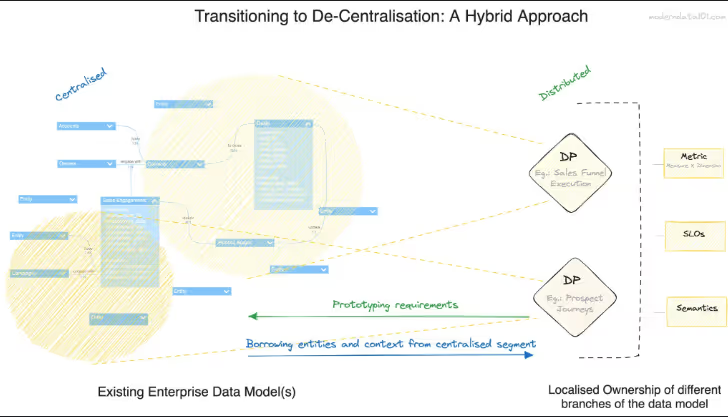
A. Centralised Governance: In centralised governance, all standards, policies, and procedures are managed by a central data team. Consistency is a benefit of this model, but it also creates bottlenecks, taking away pace and independence of the domain.
B. Hybrid Governance: The hybrid governance model combines centralised oversight with execution at the domain level. While the core policies are centrally defined, the final implementation is delegated to the respective domain teams. This balance ensures compliance with much more flexibility and agility.
C. Decentralised Governance: In this model, governance is fully distributed. Domain teams own the data, define their own policies, and manage quality independently. This approach scales effectively in organisations where data processes are mature, but they require solid platform support and a clear definition of responsibilities; and as a pure idealistic approach, it might be challenging to implement at first take or become a disruptive strategy.
With an approach centred around data products, governance becomes automated and self-serving. Product templates can be configured with access controls, PII handling protocols, and role-based permissions, while the metadata can be auto-ingested into catalogues at the time of product creation, taking care of the discoverability and compliance factors without manual intervention. These built-in practices enable domain teams to move fast within established rules.
The resulting governance model is a robust and flexible one. Central teams still have their overview, but now they enable domain teams to create and build data products autonomously. This model offers a scalable approach where governance stays close to the data and never goes above it.
Driven by automation, product thinking, and templatisation practices, data governance automation transforms it from a bottleneck to a key driver for responsible data usage.
Effective data governance has multi-fold benefits: better data quality, improved compliance, secure data access, and a better understanding of data across the organisational board. However, these benefits are confined to how they are implemented.
Policies are fragmented, their enforcement is inconsistent, and responsibilities are not assigned properly, leading to chaos in terms of responsibility and accountability.
The impact of governance cannot meet the intent with which it was considered in the first place.
The data product approach amplifies this impact for all the right reasons. Once data starts being treated as managed and modular products, governance becomes more structured, user-friendly, and scalable. Here are a few benefits this approach brings to the table:
With data products, governance becomes a dynamic and integrated capability, and does not remain static anymore. This flexibility also makes governance highly scalable with organisational growth.
Implementing governance is one thing, but successfully implementing it across a large enterprise at scale is a different challenge altogether. Teams are fragmented, processes are inconsistent, and growing data volumes make managing things difficult for traditional data governance models.
In such situations, data products deliver a scalable solution by embedding governance into the data architecture itself. Instead of depending on centralised reviews or abrupt role assignments, governance gets effectively enforced through platform tooling, standardised templates, and clearly defined ownership.
Effective data products also cover the four pillars of data governance to perfection, as:
This shift to data products transforms governance from a bottleneck to a capability available across the entire system. It also offers a lot of confidence to teams as they can develop and deploy products confidently because the governance process is operationalised and a part of the flow.
As enterprises grow, their data aspirations also scale up, and ensuring consistency in governance across tools, teams, and workloads also becomes challenging, to say the least. This is where a **Data Developer Platform,** or DDP, becomes a strong enabler right from the foundational level.
Think about DevOps platforms and their ability to standardise the software delivery process, and you will find that a DDP is not very different. It provides the tools, infrastructure, and workflows that significantly enable data teams to build, deploy, and manage data products with built-in governance processes.
In simple terms, a DDP takes away the complexity usually associated with data platform governance, offering reusable templates, automation capabilities, and APIs, ensuring that each data product adheres to predefined governance standards. Data lineage tracking, access control policies, and cost attribution can be encoded into teams' scaffolds to create data assets.
A policy as code approach, as part of DDP’s larger modularity framework, brings embedded compliance to the fore instead of manual enforcement, which is automated, consistent, and even version-controlled.
With a templatised governance model, central teams can easily define rules while enabling domain teams to move autonomously. A product template might have default access roles, audit logging, lineage pipelines, and encryption settings. With something of this nature available, there is no need for data teams to develop compliance measures separately for each project, bringing significant control over costs.
Within the broad data governance framework, two critical policy components come to the fore:
The Data Developer Platform also acts as a bridge between data producers and platform engineering teams. While data teams do well with the autonomy to deploy products quickly and responsibly, engineering teams can set up new architectural and compliance measures at scale. In the context of DDP, governance becomes a capability of the platform itself, making it scalable at the same time.
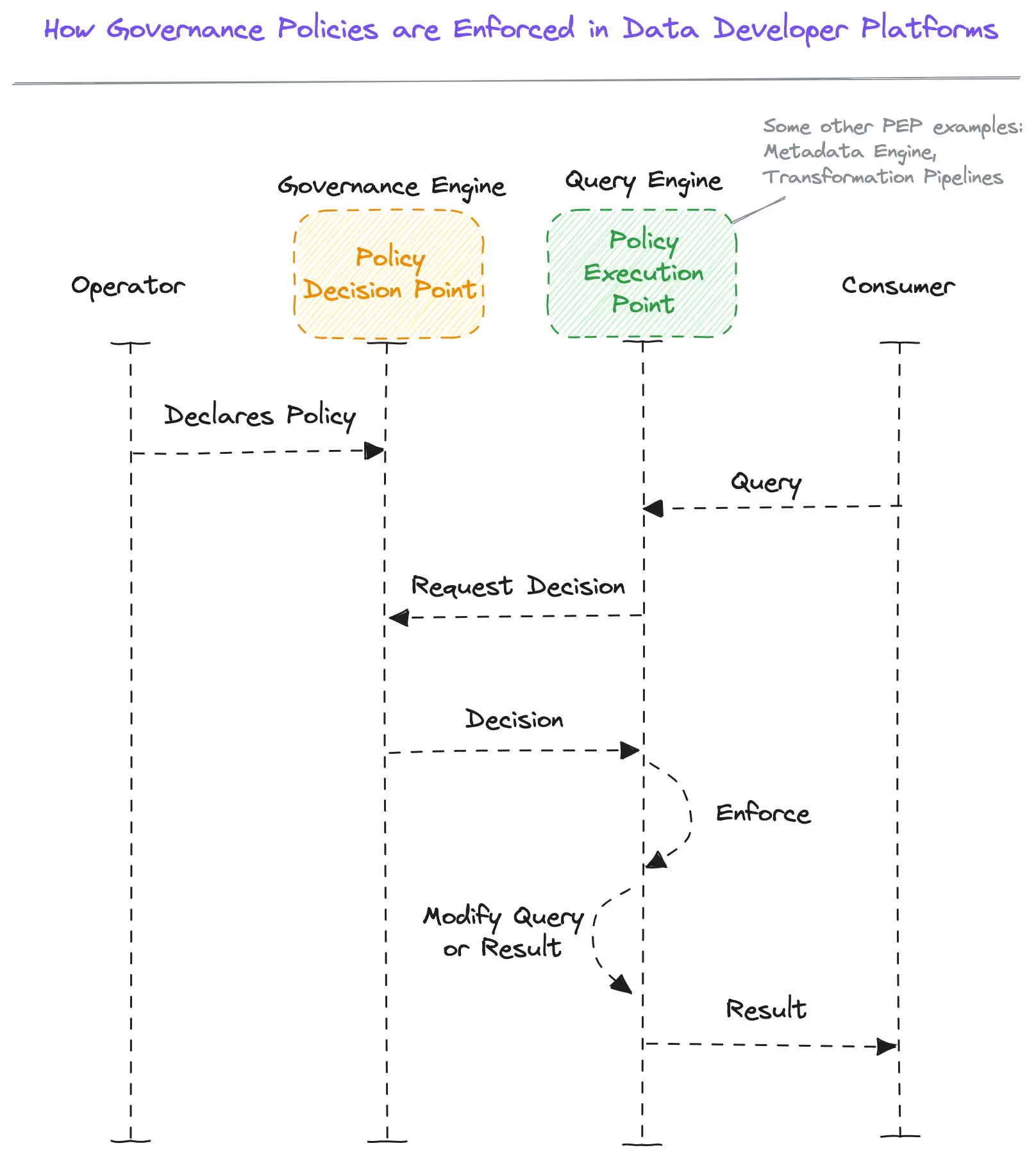
When implementing and enforcing policies in a Data Developer Platform, Policy Decision Points (PDP) and Policy Execution Points (PEP) are critical yet crucial attributes.
A Policy Decision Point acts as a central authority to ensure governance across the data ecosystem, helping in decision-making based on policies, and playing a key role in providing uniform and consistent governance. A ******PDP is where the system decides the course of action with respect to a policy. A data ecosystem cannot have more than one PDP. (Source)
On the other side are Policy Execution Points, which, as the name suggests, are points where the policies are implemented internally and externally within the data platform. There can be multiple Policy Execution Points in the data ecosystem, where different entities can implement specific policies depending upon their requirements. (Source)
From an execution point of view, the combinations of PEPs and PDP are a perfect tool-agnostic lever to ensure a hybrid governance model with a centralised overview and distributed application, implementation, and execution. In a data product world, this implies how different products with different domains could have their independent PEP points while not detaching from a centralised foundation.
To successfully implement policies, any entity is required to have a PEP compatible with the chosen PDP. Data app or data product developers use the APIs in governance engines by implementing PEPs. Putting trust in a mature data developer platform will not just help create great data products, but ensure a consistent and independent way of working without continuous bottlenecks and friction points.
There is no denying that the data product approach provides a powerful pathway to modern governance, but it's not without a few potential risks.
The proper discipline is key, and in its absence, enterprises can face new challenges with governance while thinking of them as hurdles to streamlined progress, which won't be the case.
Here are a few such challenges:
To avoid these challenges, governance needs to be intentional in every sense. Proper standards should be enforced through automation, metadata must never be taken lightly, and accountability should be a default expectation with enablement.
The future of data governance will not be top-down but rather emergent. As data product practices mature and organisations invest in robust platform support, governance will stop being separate. Still, it will become an organic outcome of how data is built, consumed, and shared.
The transition is already underway. Data contracts underline clear expectations between producers and consumers. Governance automation removes the manual overhead used to make compliance slow and reactive. Policy as code enables governance rules to be embedded directly into pipelines, allowing automated enforcement like any other code.
In this new dimension, governance is not a feared practice, but a commodity seamlessly integrated into analyst and developer experiences. There is no need to choose between agility and safety; both are ensured through design.
Data product-led governance is more innovative and deeply intertwined into each product, platform, and decision.
The true essence of data products for governance is beyond insights or analytics. At the core, it's more about ensuring operational accountability, where governance is embedded into how data is produced, consumed, and shared. When done right, data products convert governance from just an oversight into a practical capability for teams across the organisation.
With the data products approach, governance becomes a guide to data, where policies are embedded into the data lifecycle from the very first day. As a result, the modular architecture and embedded policy combination result in compliant, scalable, and trustworthy data. To sum it up, data products play a big role in making governance work for people, not just processes.
Connect with a global community of data experts to share and learn about data products, data platforms, and all things modern data! Subscribe to moderndata101.com for a host of other resources on Data Product management and more!
.avif)
📒 A Customisable Copy of the Data Product Playbook ↗️
🎬 Tune in to the Weekly Newsletter from Industry Experts ↗️
♼ Quarterly State of Data Products ↗️
🗞️ A Dedicated Feed for All Things Data ↗️
📖 End-to-End Modules with Actionable Insights ↗️
*Managed by the team at Modern
Related:
